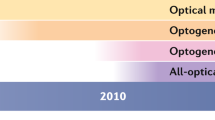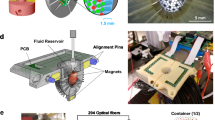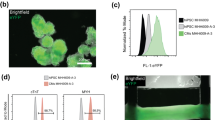Abstract
Abnormalities in the specialized cardiac conduction system may result in slow heart rate or mechanical dyssynchrony. Here we apply optogenetics, widely used to modulate neuronal excitability1,2,3,4, for cardiac pacing and resynchronization. We used adeno-associated virus (AAV) 9 to express the Channelrhodopsin-2 (ChR2) transgene at one or more ventricular sites in rats. This allowed optogenetic pacing of the hearts at different beating frequencies with blue-light illumination both in vivo and in isolated perfused hearts. Optical mapping confirmed that the source of the new pacemaker activity was the site of ChR2 transgene delivery. Notably, diffuse illumination of hearts where the ChR2 transgene was delivered to several ventricular sites resulted in electrical synchronization and significant shortening of ventricular activation times. These findings highlight the unique potential of optogenetics for cardiac pacing and resynchronization therapies.
This is a preview of subscription content, access via your institution
Access options
Subscribe to this journal
Receive 12 print issues and online access
$209.00 per year
only $17.42 per issue
Buy this article
- Purchase on Springer Link
- Instant access to full article PDF
Prices may be subject to local taxes which are calculated during checkout



Similar content being viewed by others
References
Boyden, E.S., Zhang, F., Bamberg, E., Nagel, G. & Deisseroth, K. Millisecond- timescale, genetically targeted optical control of neural activity. Nat. Neurosci. 8, 1263–1268 (2005).
Deisseroth, K. Optogenetics. Nat. Methods 8, 26–29 (2011).
Kravitz, A.V. & Kreitzer, A.C. Optogenetic manipulation of neural circuitry in vivo. Curr. Opin. Neurobiol. 21, 433–439 (2011).
Szobota, S. & Isacoff, E.Y. Optical control of neuronal activity. Annu. Rev. Biophys. 39, 329–348 (2010).
Bristow, M.R. et al. Cardiac-resynchronization therapy with or without an implantable defibrillator in advanced chronic heart failure. N. Engl. J. Med. 350, 2140–2150 (2004).
Cho, H.C. & Marban, E. Biological therapies for cardiac arrhythmias: can genes and cells replace drugs and devices? Circ. Res. 106, 674–685 (2010).
Rosen, M.R., Robinson, R.B., Brink, P.R. & Cohen, I.S. The road to biological pacing. Nat. Rev. Cardiol. 8, 656–666 (2011).
Nagel, G. et al. Channelrhodopsin-2, a directly light-gated cation-selective membrane channel. Proc. Natl. Acad. Sci. USA 100, 13940–13945 (2003).
Jia, Z. et al. Stimulating cardiac muscle by light: cardiac optogenetics by cell delivery. Circ. Arrhythm. Electrophysiol. 4, 753–760 (2011).
Nussinovitch, U., Shinnawi, R. & Gepstein, L. Modulation of cardiac tissue electrophysiological properties with light-sensitive proteins. Cardiovasc. Res. 102, 176–187 (2014).
Arrenberg, A.B., Stainier, D.Y., Baier, H. & Huisken, J. Optogenetic control of cardiac function. Science 330, 971–974 (2010).
Bruegmann, T. et al. Optogenetic control of heart muscle in vitro and in vivo. Nat. Methods 7, 897–900 (2010).
Boyle, P.M., Williams, J.C., Ambrosi, C.M., Entcheva, E. & Trayanova, N.A. A comprehensive multiscale framework for simulating optogenetics in the heart. Nat. Commun. 4, 2370 (2013).
Inagaki, K. et al. Robust systemic transduction with AAV9 vectors in mice: efficient global cardiac gene transfer superior to that of AAV8. Mol. Ther. 14, 45–53 (2006).
Wilkoff, B.L. et al. Dual-chamber pacing or ventricular backup pacing in patients with an implantable defibrillator: the Dual Chamber and VVI Implantable Defibrillator (DAVID) Trial. J. Am. Med. Assoc. 288, 3115–3123 (2002).
Miake, J., Marban, E. & Nuss, H.B. Biological pacemaker created by gene transfer. Nature 419, 132–133 (2002).
Plotnikov, A.N. et al. Biological pacemaker implanted in canine left bundle branch provides ventricular escape rhythms that have physiologically acceptable rates. Circulation 109, 506–512 (2004).
Kapoor, N., Liang, W., Marban, E. & Cho, H.C. Direct conversion of quiescent cardiomyocytes to pacemaker cells by expression of Tbx18. Nat. Biotechnol. 31, 54–62 (2012).
Kehat, I. et al. Electromechanical integration of cardiomyocytes derived from human embryonic stem cells. Nat. Biotechnol. 22, 1282–1289 (2004).
Plotnikov, A.N. et al. Xenografted adult human mesenchymal stem cells provide a platform for sustained biological pacemaker function in canine heart. Circulation 116, 706–713 (2007).
Potapova, I. et al. Human mesenchymal stem cells as a gene delivery system to create cardiac pacemakers. Circ. Res. 94, 952–959 (2004).
Lin, J.Y., Knutsen, P.M., Muller, A., Kleinfeld, D. & Tsien, R.Y. ReaChR: a red- shifted variant of channelrhodopsin enables deep transcranial optogenetic excitation. Nat. Neurosci. 16, 1499–1508 (2013).
Acknowledgements
This study was supported in part by the NOFAR project from the Office of the Chief Scientist (OCS) in the Israel Ministry of Economy, by the Israel Science Foundation (1609/14) and by the Nancy & Stephen Grand Philanthropic Fund. We thank C. Giridish for his technical help with the light sources. Also, we wish to thank I. Huber (from the Rappaport Faculty of Medicine, Technion), E. Suss-Toby, M. Holdengreber Shahar and L. Leiba (Imaging center at the Faculty of Medicine, Technion) and S. Ben Eliezer (Pathology Department, Rambam Health Center, Haifa, Israel) for their help with histological slide processing and their assistance with results analysis.
Author information
Authors and Affiliations
Contributions
U.N. and L.G. designed the experiments, U.N. performed the experiments and analyzed the results, U.N. and L.G. wrote the manuscript. All authors read and approved the manuscript.
Corresponding author
Ethics declarations
Competing interests
The authors declare no competing financial interests.
Supplementary information
Supplementary Text and Figures
Supplementary Figures 1–9, Supplementary Movie Legends (PDF 2691 kb)
Rights and permissions
About this article
Cite this article
Nussinovitch, U., Gepstein, L. Optogenetics for in vivo cardiac pacing and resynchronization therapies. Nat Biotechnol 33, 750–754 (2015). https://doi.org/10.1038/nbt.3268
Received:
Accepted:
Published:
Issue Date:
DOI: https://doi.org/10.1038/nbt.3268
This article is cited by
-
Monolithic silicon for high spatiotemporal translational photostimulation
Nature (2024)
-
Redifferentiated cardiomyocytes retain residual dedifferentiation signatures and are protected against ischemic injury
Nature Cardiovascular Research (2023)
-
Optogenetically mediated large volume suppression and synchronized excitation of human ventricular cardiomyocytes
Pflügers Archiv - European Journal of Physiology (2023)
-
Modulating cardiac physiology in engineered heart tissue with the bidirectional optogenetic tool BiPOLES
Pflügers Archiv - European Journal of Physiology (2023)
-
Cardiogenic control of affective behavioural state
Nature (2023)



